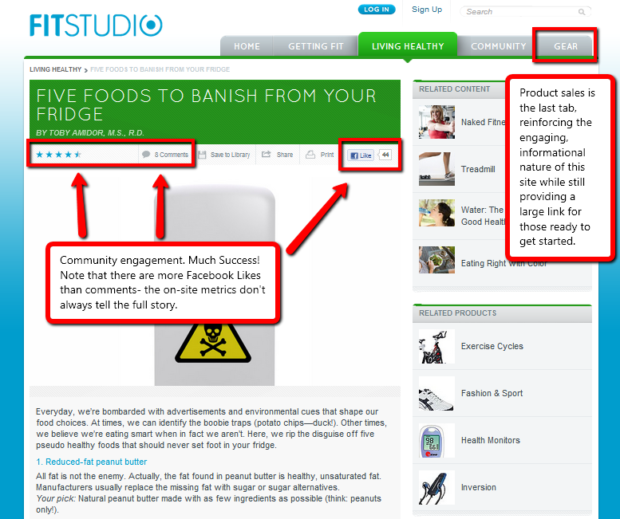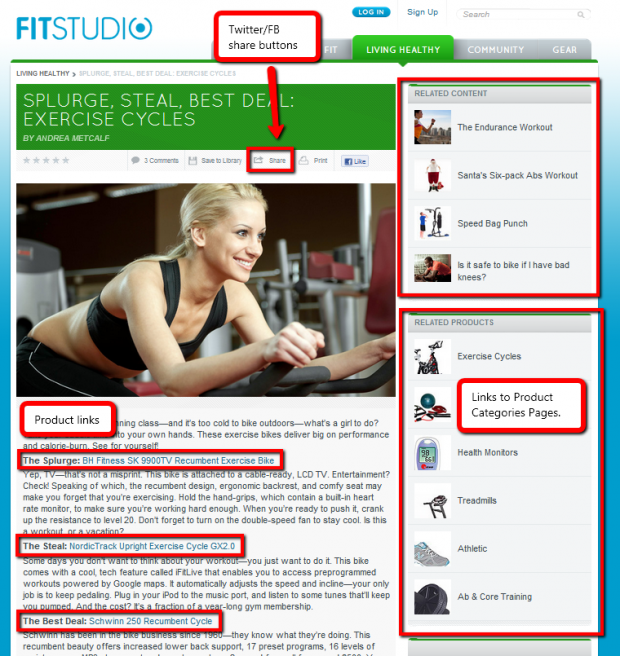Breaking From Tradition, America’s Largest Retailer of Fitness Products Turns to Content Marketing and Social Media to Generate Mindshare and Sales
Last year, I was working at a Magento PRO Partner with close ties to eBay and top Magento staff. My career up to this point had been built upon SEM and web marketing services, primarily for white-collar business with local or regional presences. This, then, gave me some new perspective and exposed me to the inner workings in another field that is traditionally overlooked or difficult to break into for many SEM agencies: medium and large eCommerce retailers.
While my daily tasks at the Magento agency taught me the technical sides of the software; the challenges of building product databases; and the need to properly plan out stores before launch; I always retained my SEO training and looked at every project through that lens. When I saw this piece last year, I knew I had to share its points with my colleagues, and I promptly launched into a short, 1,563-word email “summary” of my takeaways from the article. Since eCommerce is a passion of mine as much as SEO, I’ve decided to share this piece with you guys, and I’ve updated my initial informal email to a proper blog post. I hope you enjoy it and take away some new ideas that you can use to persuade your clients to get into content marketing.
June 2012, Forbes posted a really cool three-part write up on how several top national brands are embracing content marketing and running their marketing more like publishers than traditional PR campaigns. Primarily, this means more content and direct social engagement with their potential customers and fewer outright ads across various networks. This is a big shift for large brands, which typically thrive on PPC and banner ads, video and Facebook ads, retargeting, and often grey-area SEO schemes.
The interesting one here is Sears, which is the highlight of the linked article. To anyone who’s avoided setting foot inside a Sears store (outside of the annual excursion for Father’s Day) since its downturn a decade ago, you may be surprised to learn that Sears is the “largest retailer of fitness-related products.”
The article provides a lot of good pieces of broad information, like how the brand measures ROI, and the reminder that setting different campaign goals across different initiatives is important. What I want to focus on is Sears’ success with its content portal, FitStudio, and what information can be applied as a model for other eCommerce retailers out there.
The site’s main hub is entirely information-based, designed around getting SEO-friendly, shareable content out to the world to encourage backlinks and engagement. I’ve taken some screenshots of the pages and marked them up in Jing to make the marketing bits easier to see, which I’ll provide below.
The site is broken into 4 categories, with subcategories for each section: “Getting Fit,” focused on exercises and programs for losing weight or building muscle; “Living Healthy,” focused on diet, nutrition, and the fitness mindset; “Community,” which contains the blog, About.com-style Experts section, and the social profiles for the site’s members; and finally “Gear,” which contains reviews and advice on different types of exercise gear. This last piece ties directly into Sear’s sales goals, because each piece of equipment in their reviews and guides links to its respective product pages on one of Sears’ ecommerce sites.
Before we look at the site breakdowns, let’s hear, in her own words, what Sears’ Julia Fitzgerald, Chief Digital Officer, Fitness, Sporting Goods & Toys, has to say about the site’s direction:
“We realized that when shoppers come to Sears looking for a piece of fitness equipment, what they really are looking for is a 15 pounds lighter, fitter, or healthier version of themselves. And while the equipment is often a key component to their goal, they also need information and motivation to keep on track with a healthier lifestyle.
In addition to the advice, FitStudio is a social venue where people can connect with each other and the fitness experts for information and encouragement. While the Sears brand is successful at selling fitness equipment, we have challenged ourselves with FitStudio to extend the brand beyond the equipment and to stand for the motivation and know-how to get America in shape.”
(Underlined emphasis mine)
Now that we can see quite clearly that the focus is on social engagement and education to drive sales and branding, let’s look at how they go about this.
- Here we can see one of the articles linked from the home page. This article hits a lot of the right spots for modern content marketing rules.
- The title of the article is primarily reader-driven, not overly SEO optimized with an abundance of keywords. More powerful copywriting words, like “banish” are used in place of “get rid of.”
- Odd #s (3, 5, 7, and strangely, 10) make the best lists. Many copywriting sites have advocated this practice again and again. This is why the title of the article is a very specific 5 – not 6 or 4.
- Reinforcing the idea that this site is designed around sharing and information first and sales of equipment second, the “Gear” link is at the end of the top navigation and the “Related Products” are not actually individual products, rather categories. This is a softer selling approach.
- Every article page has multiple hooks for engaging on social media sites.
- All of the content takes an informal, conversational tone, making it non-intimidating to people just starting out, or getting back into fitness after a break (I think we can all relate to both of these feelings at some point in our life).
2. Clicking on the Exercise Cycles link on the right of the article brings us to the stationary bikes category page:
3. Following the link at the top of the page to the Exercise Bikes purchasing guide takes us to this page. This is where things really tie in between the content you write that Sears writes for the site, and the products they sell.
Here they’re providing a genuine service in highlighting some of the different classes of an exercise bike, (I honestly had no idea they varied so much in price and features, so for me, it was fairly informative) while also linking directly to their products.
This is a great way to create a useful piece of content that also steers some visitors back into their sales funnel. Notice that even this sales copy has some comments – people genuinely interact with the information presented.
Of course, not everyone is going to create a separate portal site for educating customers. But, this seems to be the way Google is pushing the industry. Gone are the days of buying masses of links and ranking overnight – sure you can still get a temporary boost, but at the end of the day thin content will get penalized. Google and all of their pundits have said it: finding relevant content has always been their primary focus, but great content with organic interaction is the new SEO currency.
In the SEO agency world, it’s often difficult to get clients to move very quickly and make dramatic changes to their business to accommodate a fully integrated content marketing strategy. However, there are plenty of things we can take away from Fitstudio and apply to our own eCommerce stores and client sites, to improve them for search engine optimization, lead generation, and customer retention.
- Write MORE.
- Get in the habit of writing content. You can start out small – any time you have an interesting thought or “What if?” about a product or type of products, write it down! Chances are, someone else has thought of that too and maybe looking for an answer. These types of “question” search queries form the “long tail” keywords of your SEO strategy and are the first opportunity to get a potential customer exposed to your brand and on your marketing list. As you begin to write more and your article lengths improve, you can begin to refine your writing style and even pick up some of the tricks mentioned above.
- Determine your audience and write to them.
- The articles above use an informal, welcoming tone. There’s no hard language or industry jargon – no BMI, no CPM (calories per minute), no fancy language that might scare off the workout newbies. The site does, however, have sections where they interview professionals for expert tips, in order to facilitate those more-advanced customers. Knowing your audience doesn’t mean you must limit your content to one particular clientele demographic.
- User Generate Content (reviews, Q&A’s, user blogs) SELL.
- At the end of the day, most people are choosing between several products, and they may not know why one is a better choice than another. Help them out here. You’re the expert, so give them an in-depth review or comparison of several products. For an electronics shop, a head-to-head comparison of the newest Android smartphones, highlighting the screen resolution differences (did you know some have full HD screens now?!), camera differences (resolution, shutter speed, ISO), processor differences (# of cores, speed, overall day-to-day “feel”), body materials and construction (Aluminum? Polycarbonate? Plastic?) are all great points to cover, and they factor into most people’s purchasing decisions. For a food store, comparing different qualities of products is another good way to create a guide – a store might detail the differences between an all-natural brand of peanut butter and the leading brand – less sugar, fewer calories, allergen immunity buildup, etc.
- Don’t be afraid to declare a winner! Especially on products that have higher profit margins or sell in higher numbers, do not be afraid to declare a winner. If you’re afraid of declaring a head-to-head winner, make a comparison article like the exercise bike one above that compares/contrasts different classes of bikes and then declares a “best buy” in each category. This way, none of the products loses against the others – they were the best of their respective classes!
- Deeply integrate your content in your store.
- As above, the main navigation showcases the content and the products equally side by side. If your niche is a bit confusing to the general consumer or has a lot of products that could use guides (like natural foods stores – educate the customer on the merits of gluten-free products, or the industry definition of “free-range” foods) then you should consider adding the content guides to the relevant sections of your store. Don’t be afraid of making the informational content part of the home page, below the first product banner/rotator.
- Get Social!
- Now, I’m probably the least likely person to cheer on social media, because I just don’t care for it much. HOWEVER, it has been proven time and time again to drive sales if done right. More importantly, the search engines are using it as a ranking signal now. Social Media is just the newest minimum requirement in doing business, much like a logo, business cards, and a website.
- Don’t focus on the business – focus on the people. I typically consider law firms to be one of the most difficult social media clients one can work with – who wants to “friend” or “like” XYZ Personal Injury Attorney? But, by thinking outside the box, one firm was able to launch a social media competition for a paid internship across Facebook, Twitter, and blogs, driving in hundreds of fresh new links and social media shares. This resulted in hundreds of family and friends of the contestants who were exposed to the brand in a positive, fun light as they voted for their contestants, bringing the law firm all kinds of free exposure.
- By “focus on the people,” I mean to focus on the lifestyle that ties into your product. Think about how your product can help people and bring it back to your brand. Sharing fitness success stories via photos on Pinterest will generate a lot more sharing than product images of your recumbent bike or free weights. As Julia mentioned above, the products are tools for customers “really looking for a (better) version of themselves.” So, discuss the art and craft of your niche, not the tools. The interest in the tools will come when the client is engaged in the craft.
I hope this “behind the scenes” look at professional big brand content marketing has inspired you to take your own steps into content marketing for your store or brand. As Brafton mentioned in the link above, content marketing is the best surefire way to “safeguard against the Google search zoo.”
Do you have any other insight or similarly stellar examples of content marketing and eCommerce done right from independent shops or big brands? Leave me a message in the notes below!








